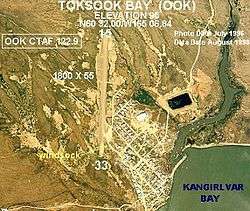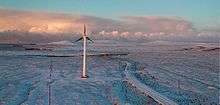Toksook Bay, Alaska
| Toksook Bay Nunakauyaq, Tuqsuq | |
|---|---|
| City | |
 Annotated aerial photograph of Toksook Bay Airport (OOK) in Toksook Bay | |
 Toksook Bay Location in Alaska | |
| Coordinates: 60°31′50″N 165°06′12″W / 60.53056°N 165.10333°WCoordinates: 60°31′50″N 165°06′12″W / 60.53056°N 165.10333°W | |
| Country | United States |
| State | Alaska |
| Census Area | Bethel |
| Incorporated | April 4, 1972[1] |
| Government | |
| • Mayor | Henry Simons |
| • State senator | Lyman Hoffman (D) |
| • State rep. | Tiffany Zulkosky (R) |
| Area[2] | |
| • Total | 73.86 sq mi (191.29 km2) |
| • Land | 32.64 sq mi (84.54 km2) |
| • Water | 41.22 sq mi (106.75 km2) |
| Elevation | 0 ft (0 m) |
| Population (2010)[3] | |
| • Total | 590 |
| • Estimate (2016)[4] | 657 |
| • Density | 8.90/sq mi (3.43/km2) |
| Time zone | UTC-9 (Alaska (AKST)) |
| • Summer (DST) | UTC-8 (AKDT) |
| ZIP code | 99637 |
| Area code | 907 |
| FIPS code | 02-78240 |
| GNIS feature ID | 1411060, 2418864 |
Toksook Bay (TOOK- sook or TUCK-sook)[5] (Nunakauyaq, Tuksuk in Central Alaskan Yup'ik) is a city[3][6] and village on Nelson Island in Bethel Census Area, Alaska. The population was 590 at the 2010 census, up from 532 in 2000. As of 2016, the estimated population was 657,[3][7] making it the largest village on the island.
Toksook Bay was established in 1964 by residents of nearby Nightmute. Almost the entire population are members of the Alaska Native Nunakauyarmiut ('People of Nunakauyaq'), who rely on fishing and other subsistence activities.
Demographics

| Historical population | |||
|---|---|---|---|
| Census | Pop. | %± | |
| 1970 | 257 | — | |
| 1980 | 333 | 29.6% | |
| 1990 | 420 | 26.1% | |
| 2000 | 532 | 26.7% | |
| 2010 | 590 | 10.9% | |
| Est. 2016 | 657 | [4] | 11.4% |
| U.S. Decennial Census[8] | |||
Toksook Bay first appeared on the 1970 U.S. Census as an unincorporated village. It formally incorporated in 1972.
As of the census[9] of 2000, there were 532 people, 106 households, and 94 families residing in the city. The population density was 16.1 people per square mile (6.2/km²). There were 110 housing units at an average density of 3.3 per square mile (1.3/km²). The racial makeup of the city was 2.44% White, 94.36% Native American, and 3.20% from two or more races.
There were 106 households out of which 68.9% had children under the age of 18 living with them, 65.1% were married couples living together, 12.3% had a female householder with no husband present, and 11.3% were non-families. 10.4% of all households were made up of individuals and 0.9% had someone living alone who was 65 years of age or older. The average household size was 5.02 and the average family size was 5.45.
In the city, the age distribution of the population shows 44.0% under the age of 18, 9.8% from 18 to 24, 27.4% from 25 to 44, 14.1% from 45 to 64, and 4.7% who were 65 years of age or older. The median age was 22 years. For every 100 females, there were 118.0 males. For every 100 females age 18 and over, there were 124.1 males.
The median income for a household in the city was $30,208, and the median income for a family was $32,188. Males had a median income of $22,813 versus $36,250 for females. The per capita income for the city was $8,761. About 26.9% of families and 27.3% of the population were below the poverty line, including 37.4% of those under age 18 and 28.6% of those age 65 or over.
Education
Lower Kuskokwim School District operates Nelson Island School, K-12.[10]
References
- ↑ 1996 Alaska Municipal Officials Directory. Juneau: Alaska Municipal League/Alaska Department of Community and Regional Affairs. January 1996. p. 152.
- ↑ "2016 U.S. Gazetteer Files". United States Census Bureau. Retrieved Jun 22, 2017.
- 1 2 3 "Toksook Bay city, Alaska". Profile of General Population and Housing Characteristics: 2010 Demographic Profile Data. United States Census Bureau. Retrieved January 23, 2013.
- 1 2 "Population and Housing Unit Estimates". Retrieved June 9, 2017.
- ↑ "Toksook Bay". Division of Community and Regional Affairs, Alaska Department of Commerce, Community and Economic Development. Retrieved January 23, 2013.
- ↑ "Alaska Taxable 2011: Municipal Taxation - Rates and Policies" (PDF). Division of Community and Regional Affairs, Alaska Department of Commerce, Community and Economic Development. January 2012. Archived from the original (PDF) on 2013-04-25.
- ↑ "Toksook Bay, Alaska". City Data. Retrieved 2016-02-16.
- ↑ "Census of Population and Housing". Census.gov. Retrieved June 4, 2015.
- ↑ "American FactFinder". United States Census Bureau. Retrieved 2008-01-31.
- ↑ "Home." Nelson Island School. Retrieved on July 13, 2018.
Further reading
- Brad Reynolds SJ and Don Doll SJ (Photographs): Eskimo Hunters of the Bering Sea, National Geographic, Vol. 165. No. 6, June 1984, pp. 814 – 834
_(cropped).jpg)
